Hospitality Consumer Behaviour and Insight
VerifiedAdded on 2023/06/13
|15
|3840
|190
AI Summary
This report explores the factors that influence consumer behaviour in the hospitality industry, including psychological, personal, cultural, and social factors. It also discusses how digital technology is changing customer trends and decision-making, and maps the path to purchase. Additionally, it compares B2B and B2C decision-making processes. The report uses the example of the landmark London, a prestigious five-star hotel that offers various services such as rooms, food, and Wi-Fi.
Contribute Materials
Your contribution can guide someone’s learning journey. Share your
documents today.
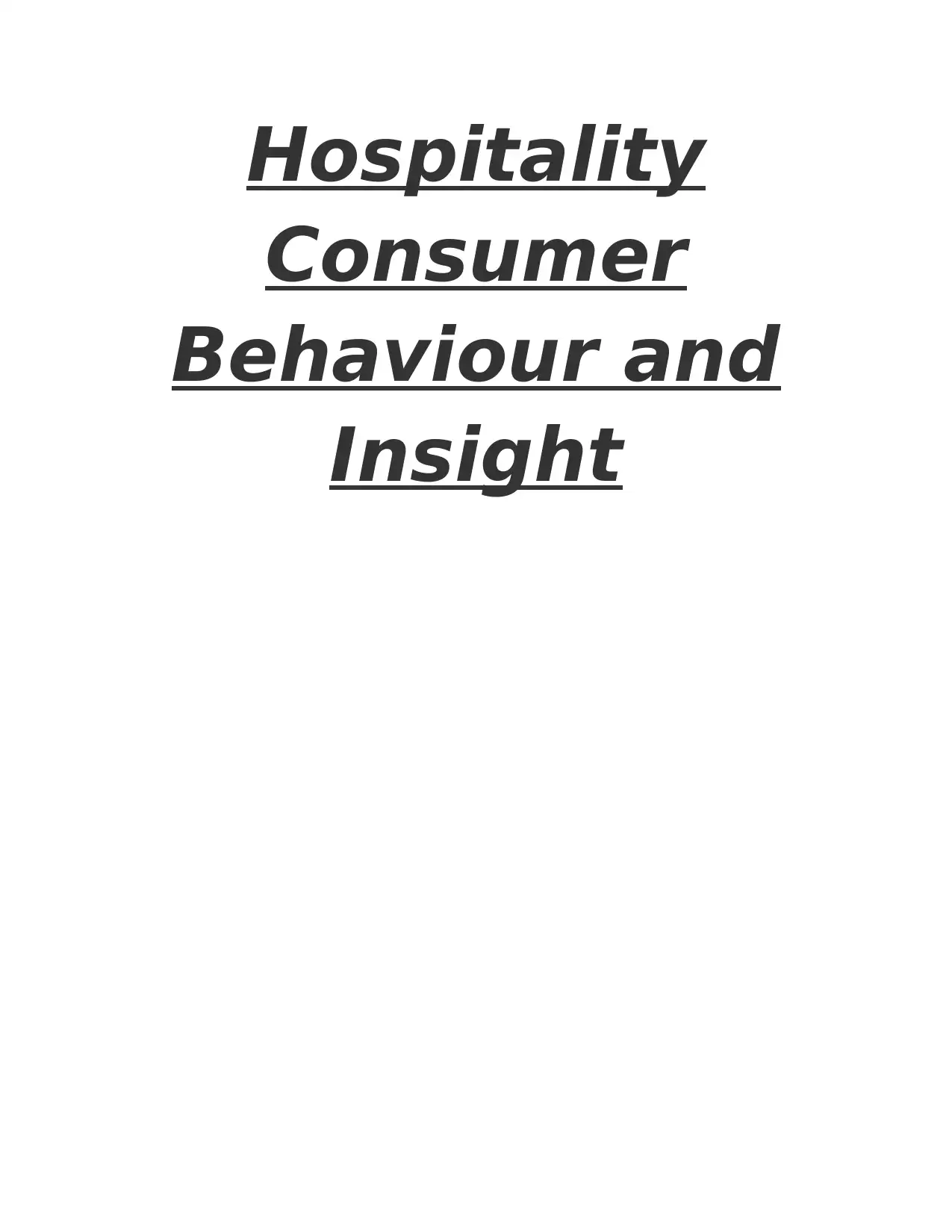
Hospitality
Consumer
Behaviour and
Insight
Consumer
Behaviour and
Insight
Secure Best Marks with AI Grader
Need help grading? Try our AI Grader for instant feedback on your assignments.
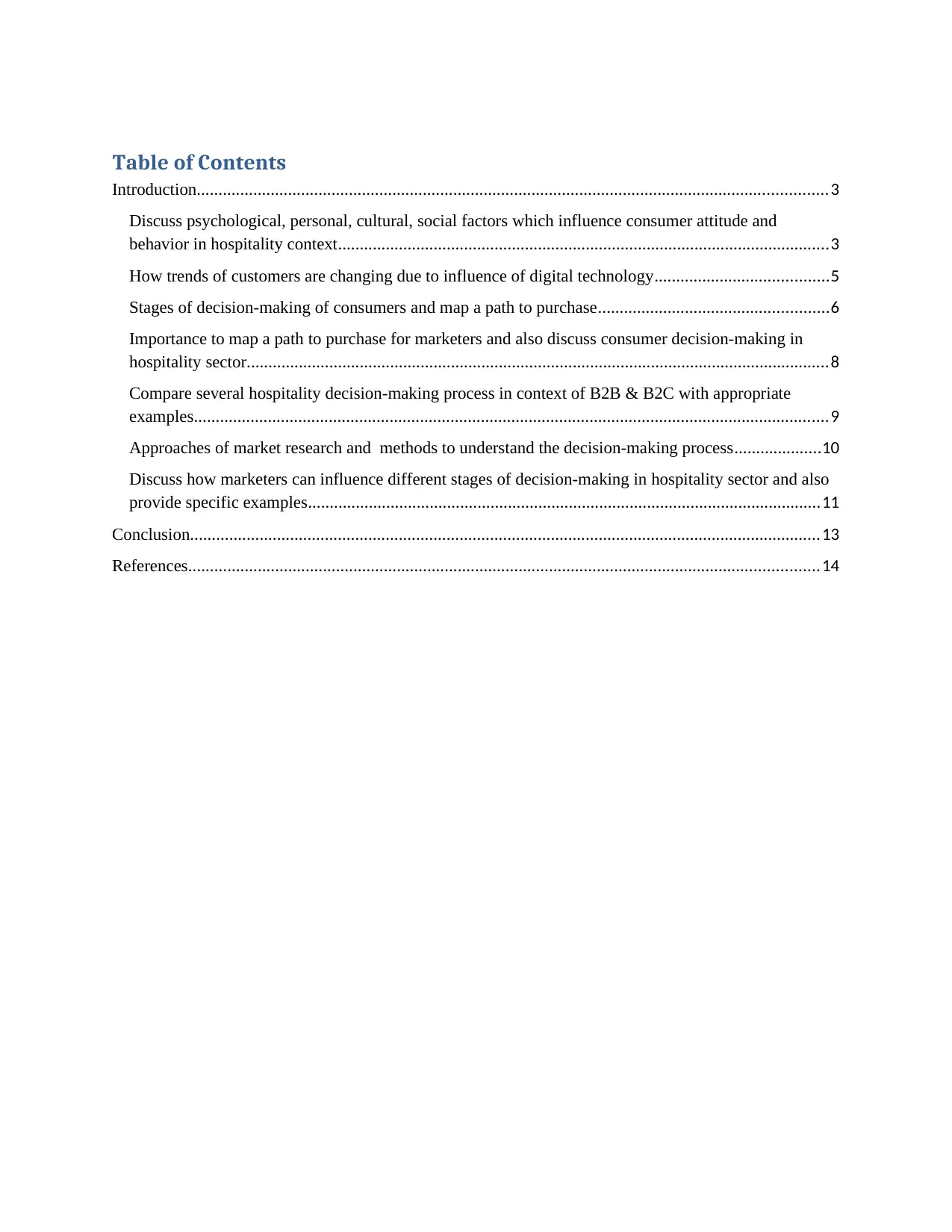
Table of Contents
Introduction.................................................................................................................................................3
Discuss psychological, personal, cultural, social factors which influence consumer attitude and
behavior in hospitality context.................................................................................................................3
How trends of customers are changing due to influence of digital technology........................................5
Stages of decision-making of consumers and map a path to purchase.....................................................6
Importance to map a path to purchase for marketers and also discuss consumer decision-making in
hospitality sector......................................................................................................................................8
Compare several hospitality decision-making process in context of B2B & B2C with appropriate
examples..................................................................................................................................................9
Approaches of market research and methods to understand the decision-making process....................10
Discuss how marketers can influence different stages of decision-making in hospitality sector and also
provide specific examples......................................................................................................................11
Conclusion.................................................................................................................................................13
References.................................................................................................................................................14
Introduction.................................................................................................................................................3
Discuss psychological, personal, cultural, social factors which influence consumer attitude and
behavior in hospitality context.................................................................................................................3
How trends of customers are changing due to influence of digital technology........................................5
Stages of decision-making of consumers and map a path to purchase.....................................................6
Importance to map a path to purchase for marketers and also discuss consumer decision-making in
hospitality sector......................................................................................................................................8
Compare several hospitality decision-making process in context of B2B & B2C with appropriate
examples..................................................................................................................................................9
Approaches of market research and methods to understand the decision-making process....................10
Discuss how marketers can influence different stages of decision-making in hospitality sector and also
provide specific examples......................................................................................................................11
Conclusion.................................................................................................................................................13
References.................................................................................................................................................14
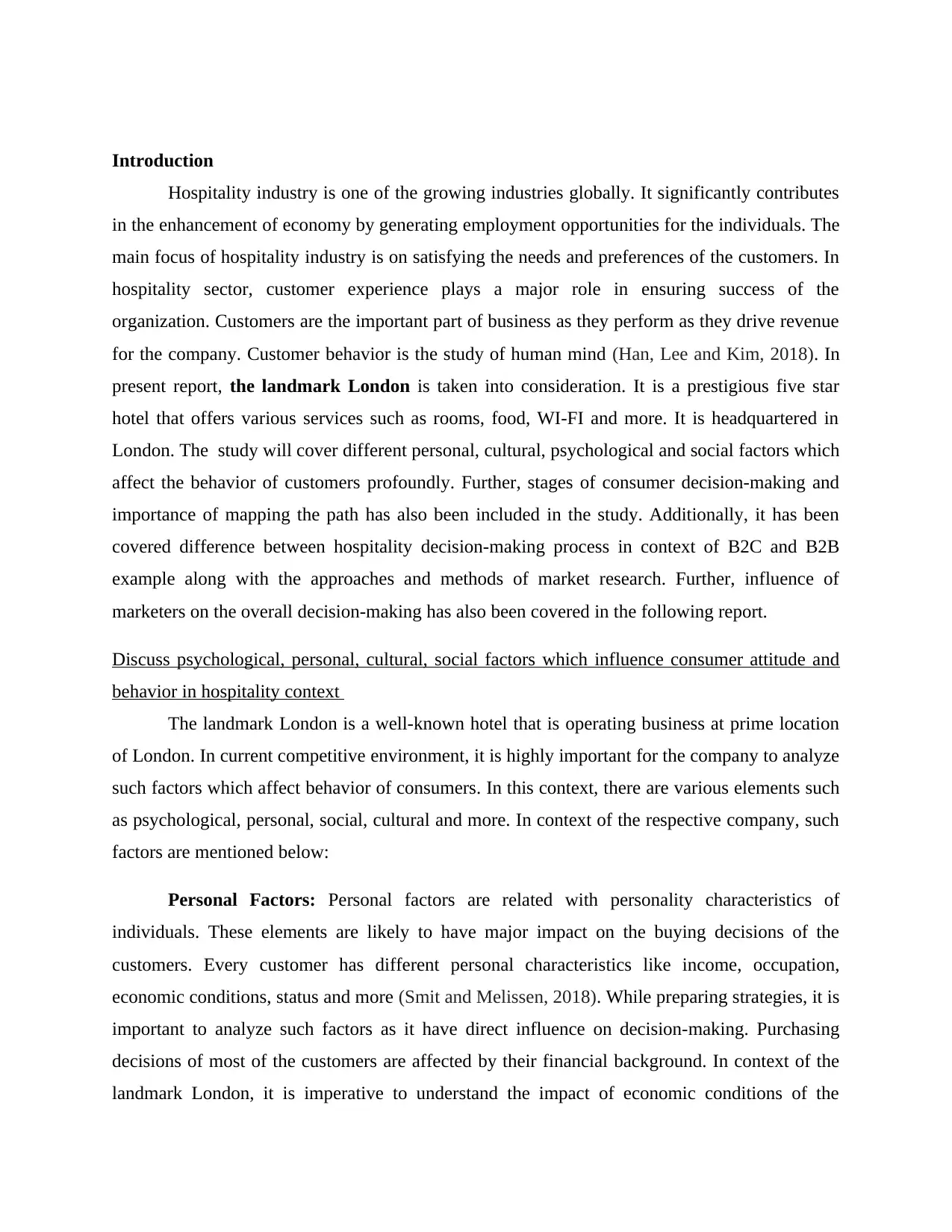
Introduction
Hospitality industry is one of the growing industries globally. It significantly contributes
in the enhancement of economy by generating employment opportunities for the individuals. The
main focus of hospitality industry is on satisfying the needs and preferences of the customers. In
hospitality sector, customer experience plays a major role in ensuring success of the
organization. Customers are the important part of business as they perform as they drive revenue
for the company. Customer behavior is the study of human mind (Han, Lee and Kim, 2018). In
present report, the landmark London is taken into consideration. It is a prestigious five star
hotel that offers various services such as rooms, food, WI-FI and more. It is headquartered in
London. The study will cover different personal, cultural, psychological and social factors which
affect the behavior of customers profoundly. Further, stages of consumer decision-making and
importance of mapping the path has also been included in the study. Additionally, it has been
covered difference between hospitality decision-making process in context of B2C and B2B
example along with the approaches and methods of market research. Further, influence of
marketers on the overall decision-making has also been covered in the following report.
Discuss psychological, personal, cultural, social factors which influence consumer attitude and
behavior in hospitality context
The landmark London is a well-known hotel that is operating business at prime location
of London. In current competitive environment, it is highly important for the company to analyze
such factors which affect behavior of consumers. In this context, there are various elements such
as psychological, personal, social, cultural and more. In context of the respective company, such
factors are mentioned below:
Personal Factors: Personal factors are related with personality characteristics of
individuals. These elements are likely to have major impact on the buying decisions of the
customers. Every customer has different personal characteristics like income, occupation,
economic conditions, status and more (Smit and Melissen, 2018). While preparing strategies, it is
important to analyze such factors as it have direct influence on decision-making. Purchasing
decisions of most of the customers are affected by their financial background. In context of the
landmark London, it is imperative to understand the impact of economic conditions of the
Hospitality industry is one of the growing industries globally. It significantly contributes
in the enhancement of economy by generating employment opportunities for the individuals. The
main focus of hospitality industry is on satisfying the needs and preferences of the customers. In
hospitality sector, customer experience plays a major role in ensuring success of the
organization. Customers are the important part of business as they perform as they drive revenue
for the company. Customer behavior is the study of human mind (Han, Lee and Kim, 2018). In
present report, the landmark London is taken into consideration. It is a prestigious five star
hotel that offers various services such as rooms, food, WI-FI and more. It is headquartered in
London. The study will cover different personal, cultural, psychological and social factors which
affect the behavior of customers profoundly. Further, stages of consumer decision-making and
importance of mapping the path has also been included in the study. Additionally, it has been
covered difference between hospitality decision-making process in context of B2C and B2B
example along with the approaches and methods of market research. Further, influence of
marketers on the overall decision-making has also been covered in the following report.
Discuss psychological, personal, cultural, social factors which influence consumer attitude and
behavior in hospitality context
The landmark London is a well-known hotel that is operating business at prime location
of London. In current competitive environment, it is highly important for the company to analyze
such factors which affect behavior of consumers. In this context, there are various elements such
as psychological, personal, social, cultural and more. In context of the respective company, such
factors are mentioned below:
Personal Factors: Personal factors are related with personality characteristics of
individuals. These elements are likely to have major impact on the buying decisions of the
customers. Every customer has different personal characteristics like income, occupation,
economic conditions, status and more (Smit and Melissen, 2018). While preparing strategies, it is
important to analyze such factors as it have direct influence on decision-making. Purchasing
decisions of most of the customers are affected by their financial background. In context of the
landmark London, it is imperative to understand the impact of economic conditions of the
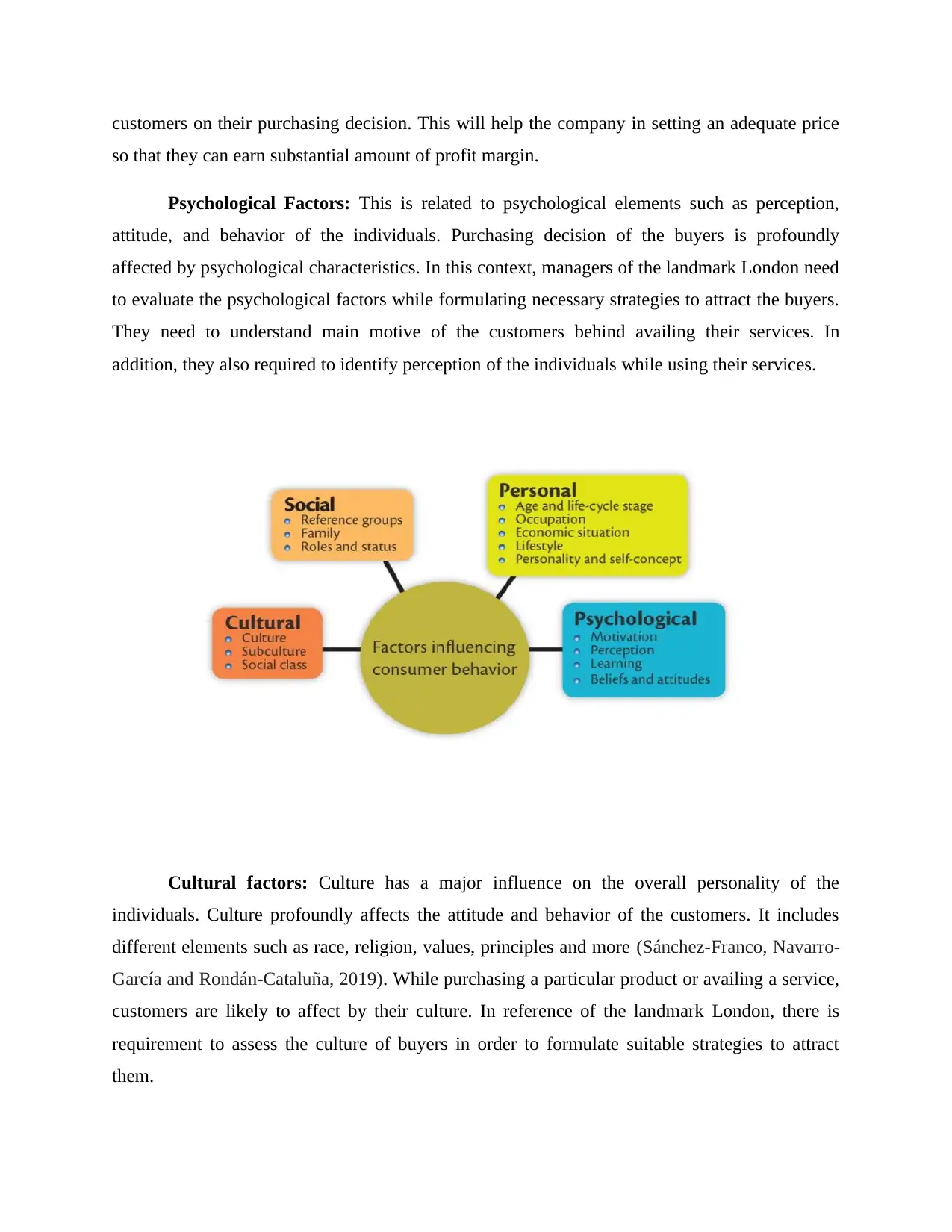
customers on their purchasing decision. This will help the company in setting an adequate price
so that they can earn substantial amount of profit margin.
Psychological Factors: This is related to psychological elements such as perception,
attitude, and behavior of the individuals. Purchasing decision of the buyers is profoundly
affected by psychological characteristics. In this context, managers of the landmark London need
to evaluate the psychological factors while formulating necessary strategies to attract the buyers.
They need to understand main motive of the customers behind availing their services. In
addition, they also required to identify perception of the individuals while using their services.
Cultural factors: Culture has a major influence on the overall personality of the
individuals. Culture profoundly affects the attitude and behavior of the customers. It includes
different elements such as race, religion, values, principles and more (Sánchez-Franco, Navarro-
García and Rondán-Cataluña, 2019). While purchasing a particular product or availing a service,
customers are likely to affect by their culture. In reference of the landmark London, there is
requirement to assess the culture of buyers in order to formulate suitable strategies to attract
them.
so that they can earn substantial amount of profit margin.
Psychological Factors: This is related to psychological elements such as perception,
attitude, and behavior of the individuals. Purchasing decision of the buyers is profoundly
affected by psychological characteristics. In this context, managers of the landmark London need
to evaluate the psychological factors while formulating necessary strategies to attract the buyers.
They need to understand main motive of the customers behind availing their services. In
addition, they also required to identify perception of the individuals while using their services.
Cultural factors: Culture has a major influence on the overall personality of the
individuals. Culture profoundly affects the attitude and behavior of the customers. It includes
different elements such as race, religion, values, principles and more (Sánchez-Franco, Navarro-
García and Rondán-Cataluña, 2019). While purchasing a particular product or availing a service,
customers are likely to affect by their culture. In reference of the landmark London, there is
requirement to assess the culture of buyers in order to formulate suitable strategies to attract
them.
Secure Best Marks with AI Grader
Need help grading? Try our AI Grader for instant feedback on your assignments.
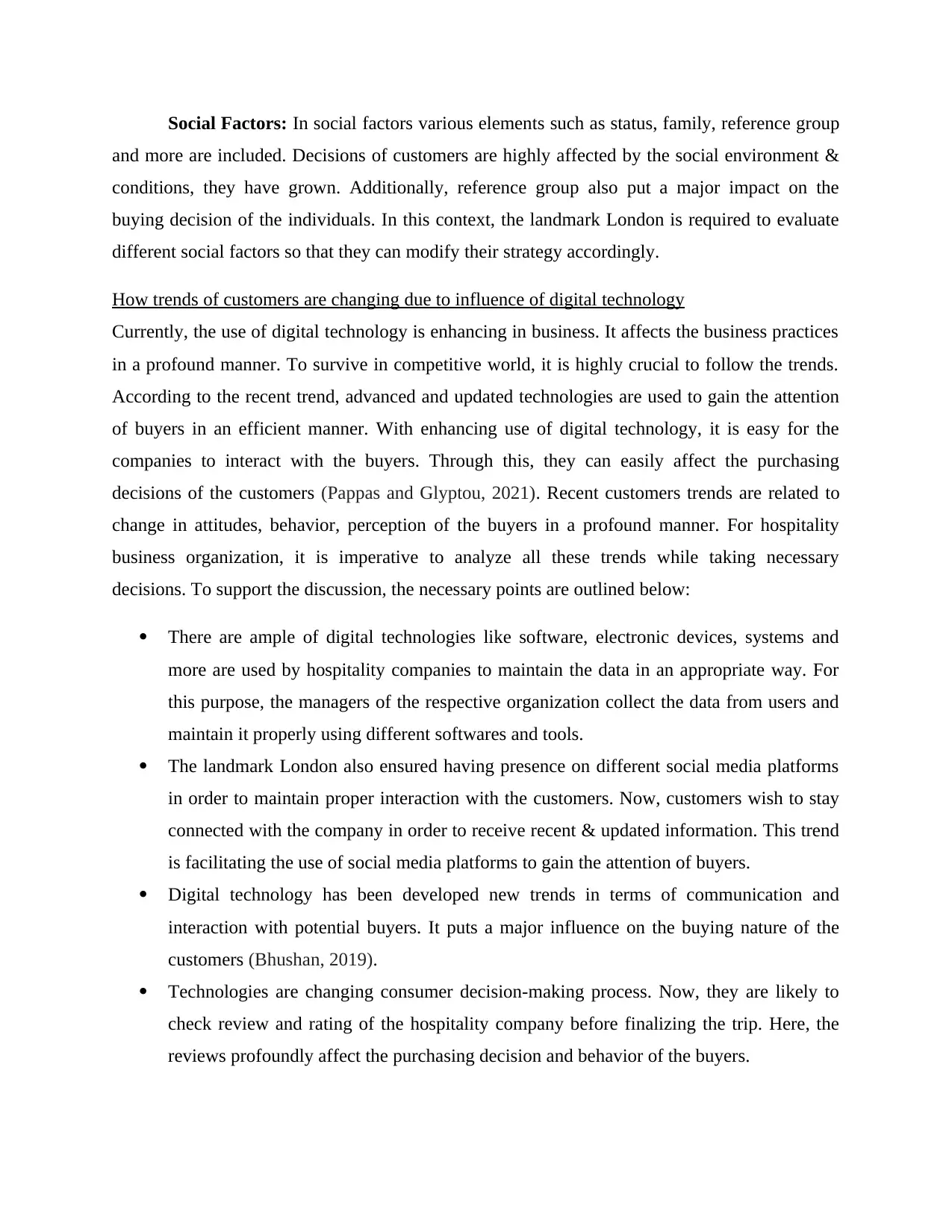
Social Factors: In social factors various elements such as status, family, reference group
and more are included. Decisions of customers are highly affected by the social environment &
conditions, they have grown. Additionally, reference group also put a major impact on the
buying decision of the individuals. In this context, the landmark London is required to evaluate
different social factors so that they can modify their strategy accordingly.
How trends of customers are changing due to influence of digital technology
Currently, the use of digital technology is enhancing in business. It affects the business practices
in a profound manner. To survive in competitive world, it is highly crucial to follow the trends.
According to the recent trend, advanced and updated technologies are used to gain the attention
of buyers in an efficient manner. With enhancing use of digital technology, it is easy for the
companies to interact with the buyers. Through this, they can easily affect the purchasing
decisions of the customers (Pappas and Glyptou, 2021). Recent customers trends are related to
change in attitudes, behavior, perception of the buyers in a profound manner. For hospitality
business organization, it is imperative to analyze all these trends while taking necessary
decisions. To support the discussion, the necessary points are outlined below:
There are ample of digital technologies like software, electronic devices, systems and
more are used by hospitality companies to maintain the data in an appropriate way. For
this purpose, the managers of the respective organization collect the data from users and
maintain it properly using different softwares and tools.
The landmark London also ensured having presence on different social media platforms
in order to maintain proper interaction with the customers. Now, customers wish to stay
connected with the company in order to receive recent & updated information. This trend
is facilitating the use of social media platforms to gain the attention of buyers.
Digital technology has been developed new trends in terms of communication and
interaction with potential buyers. It puts a major influence on the buying nature of the
customers (Bhushan, 2019).
Technologies are changing consumer decision-making process. Now, they are likely to
check review and rating of the hospitality company before finalizing the trip. Here, the
reviews profoundly affect the purchasing decision and behavior of the buyers.
and more are included. Decisions of customers are highly affected by the social environment &
conditions, they have grown. Additionally, reference group also put a major impact on the
buying decision of the individuals. In this context, the landmark London is required to evaluate
different social factors so that they can modify their strategy accordingly.
How trends of customers are changing due to influence of digital technology
Currently, the use of digital technology is enhancing in business. It affects the business practices
in a profound manner. To survive in competitive world, it is highly crucial to follow the trends.
According to the recent trend, advanced and updated technologies are used to gain the attention
of buyers in an efficient manner. With enhancing use of digital technology, it is easy for the
companies to interact with the buyers. Through this, they can easily affect the purchasing
decisions of the customers (Pappas and Glyptou, 2021). Recent customers trends are related to
change in attitudes, behavior, perception of the buyers in a profound manner. For hospitality
business organization, it is imperative to analyze all these trends while taking necessary
decisions. To support the discussion, the necessary points are outlined below:
There are ample of digital technologies like software, electronic devices, systems and
more are used by hospitality companies to maintain the data in an appropriate way. For
this purpose, the managers of the respective organization collect the data from users and
maintain it properly using different softwares and tools.
The landmark London also ensured having presence on different social media platforms
in order to maintain proper interaction with the customers. Now, customers wish to stay
connected with the company in order to receive recent & updated information. This trend
is facilitating the use of social media platforms to gain the attention of buyers.
Digital technology has been developed new trends in terms of communication and
interaction with potential buyers. It puts a major influence on the buying nature of the
customers (Bhushan, 2019).
Technologies are changing consumer decision-making process. Now, they are likely to
check review and rating of the hospitality company before finalizing the trip. Here, the
reviews profoundly affect the purchasing decision and behavior of the buyers.
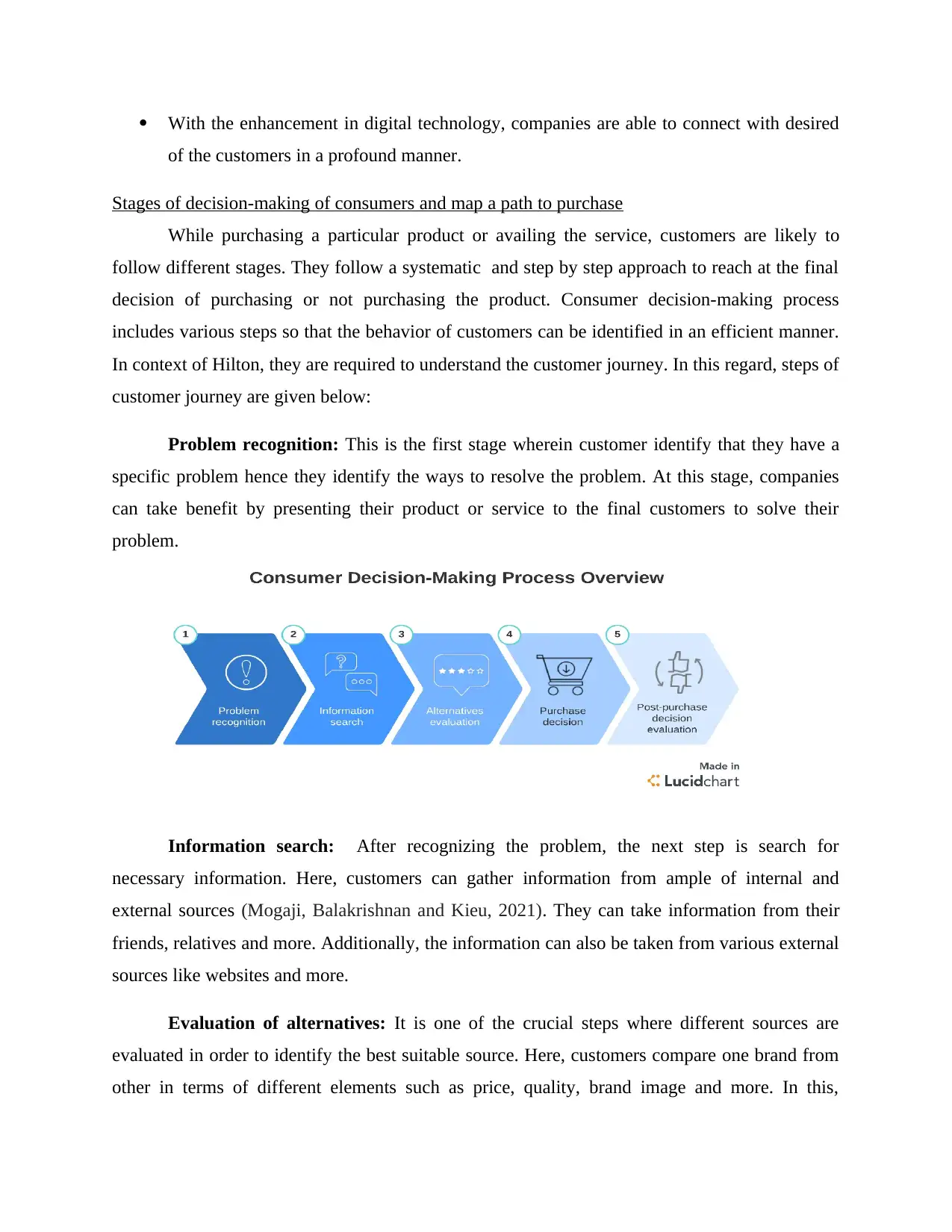
With the enhancement in digital technology, companies are able to connect with desired
of the customers in a profound manner.
Stages of decision-making of consumers and map a path to purchase
While purchasing a particular product or availing the service, customers are likely to
follow different stages. They follow a systematic and step by step approach to reach at the final
decision of purchasing or not purchasing the product. Consumer decision-making process
includes various steps so that the behavior of customers can be identified in an efficient manner.
In context of Hilton, they are required to understand the customer journey. In this regard, steps of
customer journey are given below:
Problem recognition: This is the first stage wherein customer identify that they have a
specific problem hence they identify the ways to resolve the problem. At this stage, companies
can take benefit by presenting their product or service to the final customers to solve their
problem.
Information search: After recognizing the problem, the next step is search for
necessary information. Here, customers can gather information from ample of internal and
external sources (Mogaji, Balakrishnan and Kieu, 2021). They can take information from their
friends, relatives and more. Additionally, the information can also be taken from various external
sources like websites and more.
Evaluation of alternatives: It is one of the crucial steps where different sources are
evaluated in order to identify the best suitable source. Here, customers compare one brand from
other in terms of different elements such as price, quality, brand image and more. In this,
of the customers in a profound manner.
Stages of decision-making of consumers and map a path to purchase
While purchasing a particular product or availing the service, customers are likely to
follow different stages. They follow a systematic and step by step approach to reach at the final
decision of purchasing or not purchasing the product. Consumer decision-making process
includes various steps so that the behavior of customers can be identified in an efficient manner.
In context of Hilton, they are required to understand the customer journey. In this regard, steps of
customer journey are given below:
Problem recognition: This is the first stage wherein customer identify that they have a
specific problem hence they identify the ways to resolve the problem. At this stage, companies
can take benefit by presenting their product or service to the final customers to solve their
problem.
Information search: After recognizing the problem, the next step is search for
necessary information. Here, customers can gather information from ample of internal and
external sources (Mogaji, Balakrishnan and Kieu, 2021). They can take information from their
friends, relatives and more. Additionally, the information can also be taken from various external
sources like websites and more.
Evaluation of alternatives: It is one of the crucial steps where different sources are
evaluated in order to identify the best suitable source. Here, customers compare one brand from
other in terms of different elements such as price, quality, brand image and more. In this,
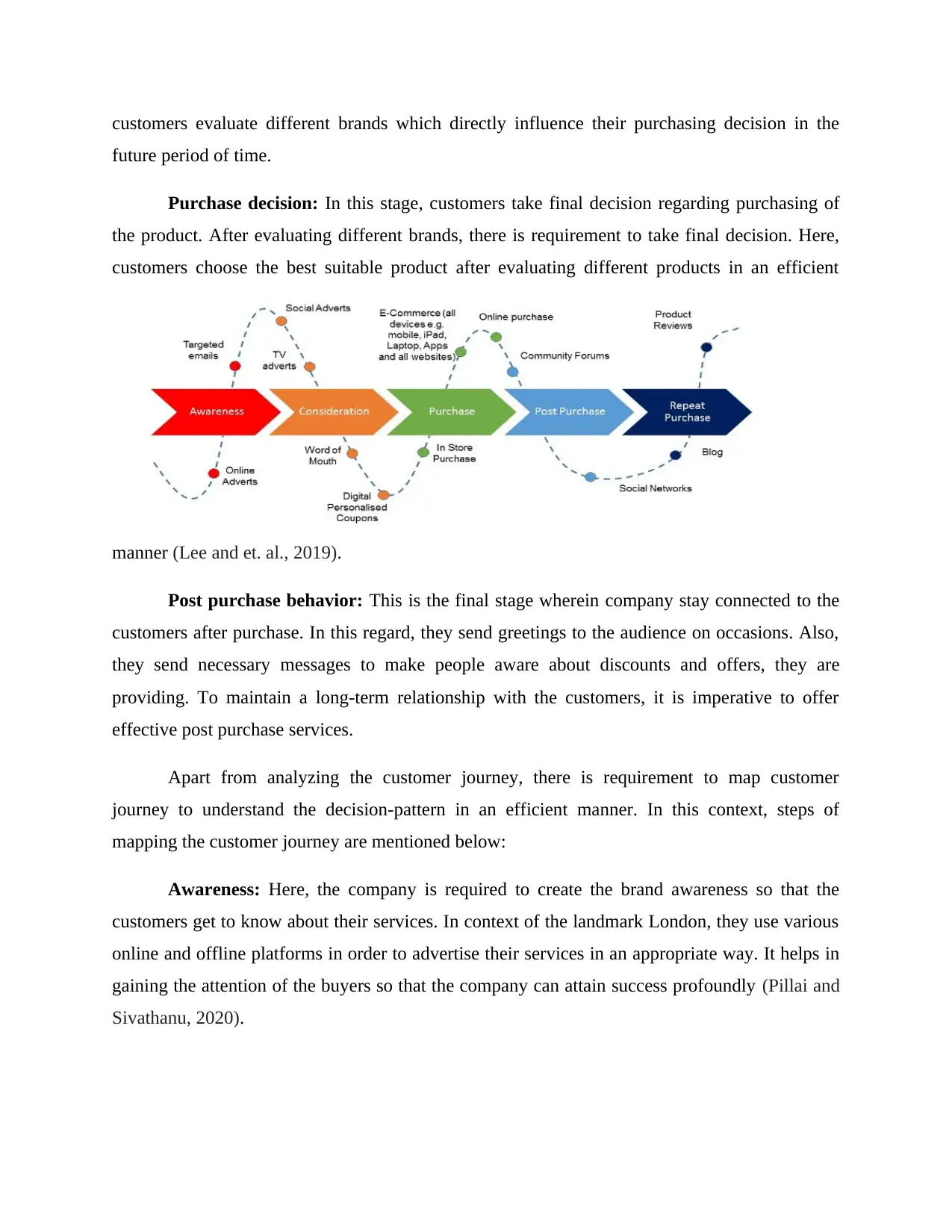
customers evaluate different brands which directly influence their purchasing decision in the
future period of time.
Purchase decision: In this stage, customers take final decision regarding purchasing of
the product. After evaluating different brands, there is requirement to take final decision. Here,
customers choose the best suitable product after evaluating different products in an efficient
manner (Lee and et. al., 2019).
Post purchase behavior: This is the final stage wherein company stay connected to the
customers after purchase. In this regard, they send greetings to the audience on occasions. Also,
they send necessary messages to make people aware about discounts and offers, they are
providing. To maintain a long-term relationship with the customers, it is imperative to offer
effective post purchase services.
Apart from analyzing the customer journey, there is requirement to map customer
journey to understand the decision-pattern in an efficient manner. In this context, steps of
mapping the customer journey are mentioned below:
Awareness: Here, the company is required to create the brand awareness so that the
customers get to know about their services. In context of the landmark London, they use various
online and offline platforms in order to advertise their services in an appropriate way. It helps in
gaining the attention of the buyers so that the company can attain success profoundly (Pillai and
Sivathanu, 2020).
future period of time.
Purchase decision: In this stage, customers take final decision regarding purchasing of
the product. After evaluating different brands, there is requirement to take final decision. Here,
customers choose the best suitable product after evaluating different products in an efficient
manner (Lee and et. al., 2019).
Post purchase behavior: This is the final stage wherein company stay connected to the
customers after purchase. In this regard, they send greetings to the audience on occasions. Also,
they send necessary messages to make people aware about discounts and offers, they are
providing. To maintain a long-term relationship with the customers, it is imperative to offer
effective post purchase services.
Apart from analyzing the customer journey, there is requirement to map customer
journey to understand the decision-pattern in an efficient manner. In this context, steps of
mapping the customer journey are mentioned below:
Awareness: Here, the company is required to create the brand awareness so that the
customers get to know about their services. In context of the landmark London, they use various
online and offline platforms in order to advertise their services in an appropriate way. It helps in
gaining the attention of the buyers so that the company can attain success profoundly (Pillai and
Sivathanu, 2020).
Paraphrase This Document
Need a fresh take? Get an instant paraphrase of this document with our AI Paraphraser
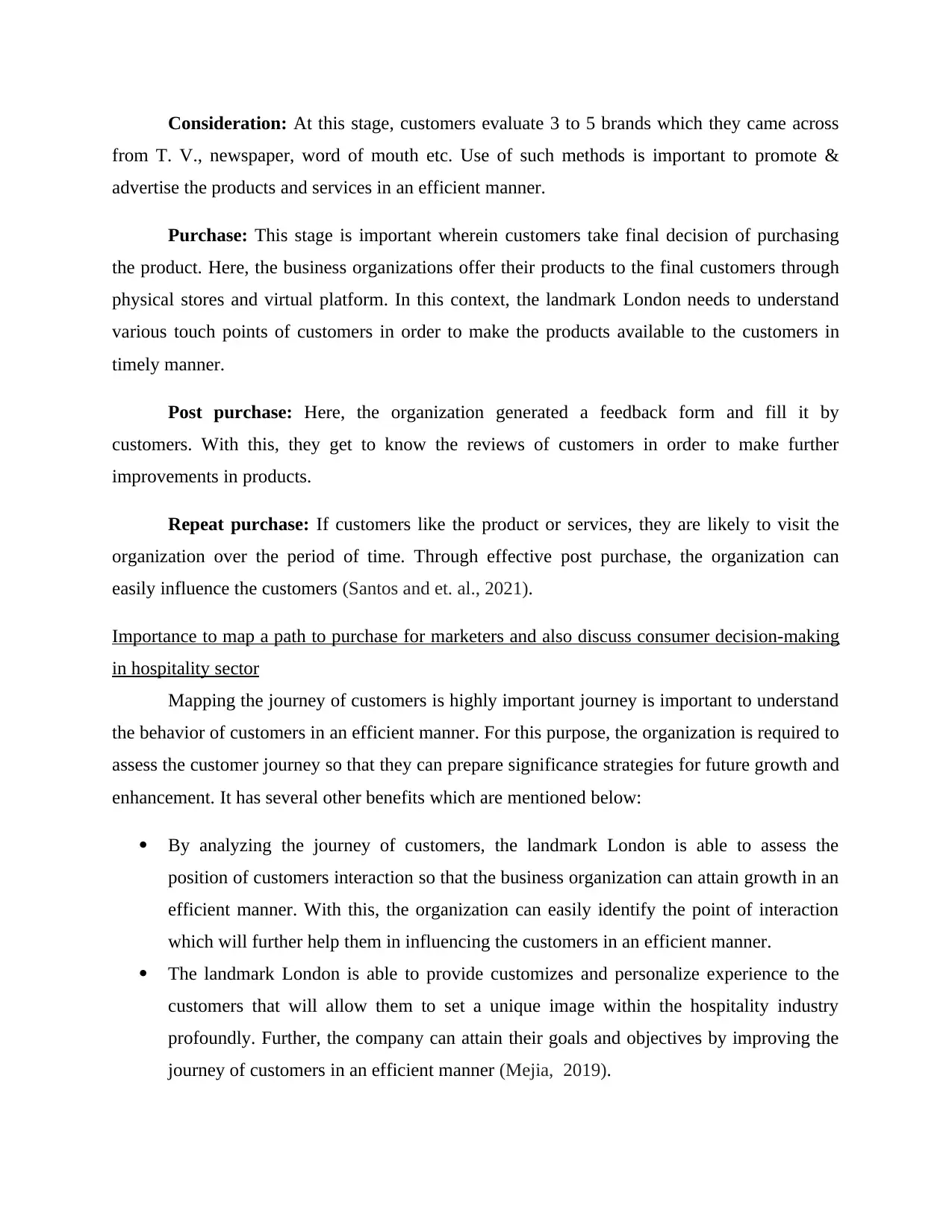
Consideration: At this stage, customers evaluate 3 to 5 brands which they came across
from T. V., newspaper, word of mouth etc. Use of such methods is important to promote &
advertise the products and services in an efficient manner.
Purchase: This stage is important wherein customers take final decision of purchasing
the product. Here, the business organizations offer their products to the final customers through
physical stores and virtual platform. In this context, the landmark London needs to understand
various touch points of customers in order to make the products available to the customers in
timely manner.
Post purchase: Here, the organization generated a feedback form and fill it by
customers. With this, they get to know the reviews of customers in order to make further
improvements in products.
Repeat purchase: If customers like the product or services, they are likely to visit the
organization over the period of time. Through effective post purchase, the organization can
easily influence the customers (Santos and et. al., 2021).
Importance to map a path to purchase for marketers and also discuss consumer decision-making
in hospitality sector
Mapping the journey of customers is highly important journey is important to understand
the behavior of customers in an efficient manner. For this purpose, the organization is required to
assess the customer journey so that they can prepare significance strategies for future growth and
enhancement. It has several other benefits which are mentioned below:
By analyzing the journey of customers, the landmark London is able to assess the
position of customers interaction so that the business organization can attain growth in an
efficient manner. With this, the organization can easily identify the point of interaction
which will further help them in influencing the customers in an efficient manner.
The landmark London is able to provide customizes and personalize experience to the
customers that will allow them to set a unique image within the hospitality industry
profoundly. Further, the company can attain their goals and objectives by improving the
journey of customers in an efficient manner (Mejia, 2019).
from T. V., newspaper, word of mouth etc. Use of such methods is important to promote &
advertise the products and services in an efficient manner.
Purchase: This stage is important wherein customers take final decision of purchasing
the product. Here, the business organizations offer their products to the final customers through
physical stores and virtual platform. In this context, the landmark London needs to understand
various touch points of customers in order to make the products available to the customers in
timely manner.
Post purchase: Here, the organization generated a feedback form and fill it by
customers. With this, they get to know the reviews of customers in order to make further
improvements in products.
Repeat purchase: If customers like the product or services, they are likely to visit the
organization over the period of time. Through effective post purchase, the organization can
easily influence the customers (Santos and et. al., 2021).
Importance to map a path to purchase for marketers and also discuss consumer decision-making
in hospitality sector
Mapping the journey of customers is highly important journey is important to understand
the behavior of customers in an efficient manner. For this purpose, the organization is required to
assess the customer journey so that they can prepare significance strategies for future growth and
enhancement. It has several other benefits which are mentioned below:
By analyzing the journey of customers, the landmark London is able to assess the
position of customers interaction so that the business organization can attain growth in an
efficient manner. With this, the organization can easily identify the point of interaction
which will further help them in influencing the customers in an efficient manner.
The landmark London is able to provide customizes and personalize experience to the
customers that will allow them to set a unique image within the hospitality industry
profoundly. Further, the company can attain their goals and objectives by improving the
journey of customers in an efficient manner (Mejia, 2019).
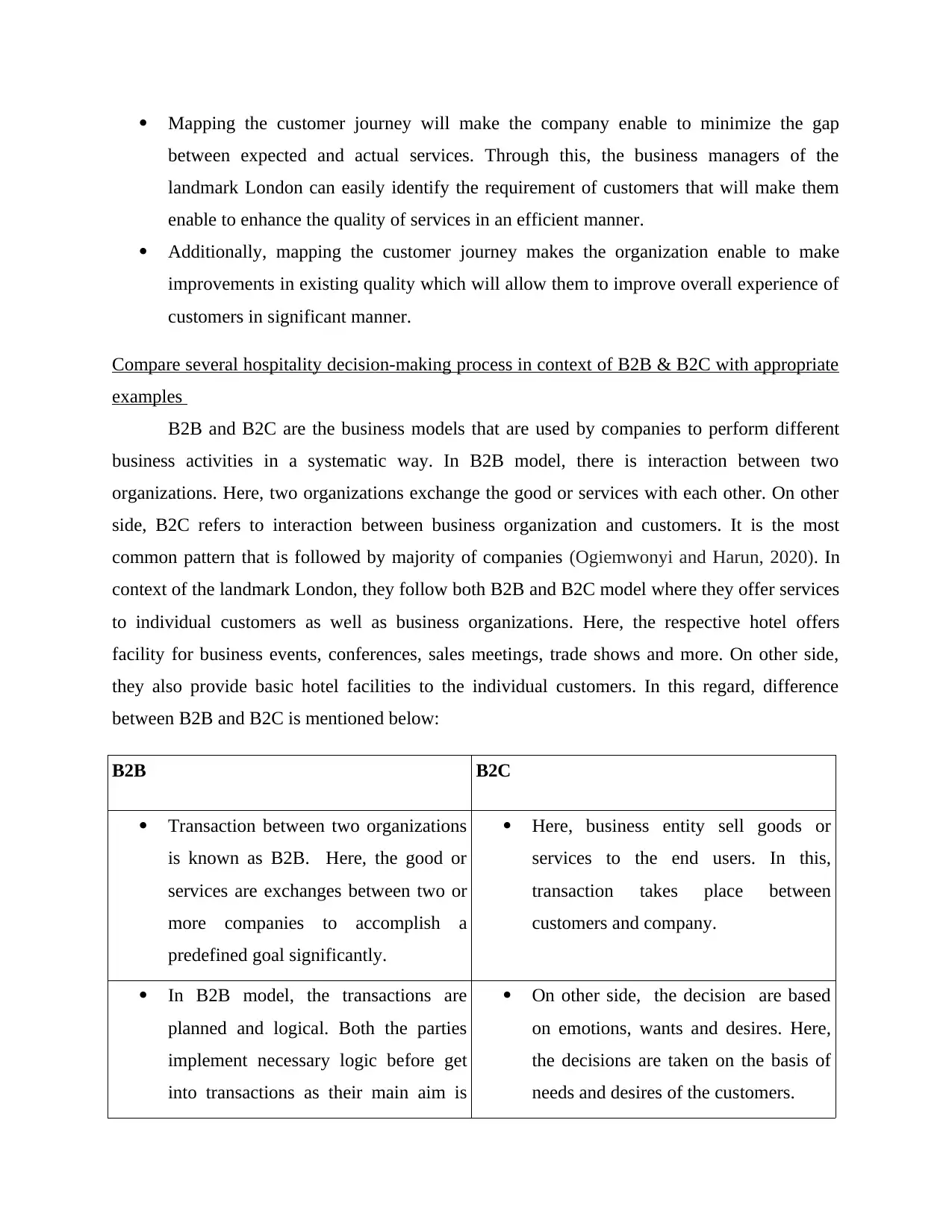
Mapping the customer journey will make the company enable to minimize the gap
between expected and actual services. Through this, the business managers of the
landmark London can easily identify the requirement of customers that will make them
enable to enhance the quality of services in an efficient manner.
Additionally, mapping the customer journey makes the organization enable to make
improvements in existing quality which will allow them to improve overall experience of
customers in significant manner.
Compare several hospitality decision-making process in context of B2B & B2C with appropriate
examples
B2B and B2C are the business models that are used by companies to perform different
business activities in a systematic way. In B2B model, there is interaction between two
organizations. Here, two organizations exchange the good or services with each other. On other
side, B2C refers to interaction between business organization and customers. It is the most
common pattern that is followed by majority of companies (Ogiemwonyi and Harun, 2020). In
context of the landmark London, they follow both B2B and B2C model where they offer services
to individual customers as well as business organizations. Here, the respective hotel offers
facility for business events, conferences, sales meetings, trade shows and more. On other side,
they also provide basic hotel facilities to the individual customers. In this regard, difference
between B2B and B2C is mentioned below:
B2B B2C
Transaction between two organizations
is known as B2B. Here, the good or
services are exchanges between two or
more companies to accomplish a
predefined goal significantly.
Here, business entity sell goods or
services to the end users. In this,
transaction takes place between
customers and company.
In B2B model, the transactions are
planned and logical. Both the parties
implement necessary logic before get
into transactions as their main aim is
On other side, the decision are based
on emotions, wants and desires. Here,
the decisions are taken on the basis of
needs and desires of the customers.
between expected and actual services. Through this, the business managers of the
landmark London can easily identify the requirement of customers that will make them
enable to enhance the quality of services in an efficient manner.
Additionally, mapping the customer journey makes the organization enable to make
improvements in existing quality which will allow them to improve overall experience of
customers in significant manner.
Compare several hospitality decision-making process in context of B2B & B2C with appropriate
examples
B2B and B2C are the business models that are used by companies to perform different
business activities in a systematic way. In B2B model, there is interaction between two
organizations. Here, two organizations exchange the good or services with each other. On other
side, B2C refers to interaction between business organization and customers. It is the most
common pattern that is followed by majority of companies (Ogiemwonyi and Harun, 2020). In
context of the landmark London, they follow both B2B and B2C model where they offer services
to individual customers as well as business organizations. Here, the respective hotel offers
facility for business events, conferences, sales meetings, trade shows and more. On other side,
they also provide basic hotel facilities to the individual customers. In this regard, difference
between B2B and B2C is mentioned below:
B2B B2C
Transaction between two organizations
is known as B2B. Here, the good or
services are exchanges between two or
more companies to accomplish a
predefined goal significantly.
Here, business entity sell goods or
services to the end users. In this,
transaction takes place between
customers and company.
In B2B model, the transactions are
planned and logical. Both the parties
implement necessary logic before get
into transactions as their main aim is
On other side, the decision are based
on emotions, wants and desires. Here,
the decisions are taken on the basis of
needs and desires of the customers.
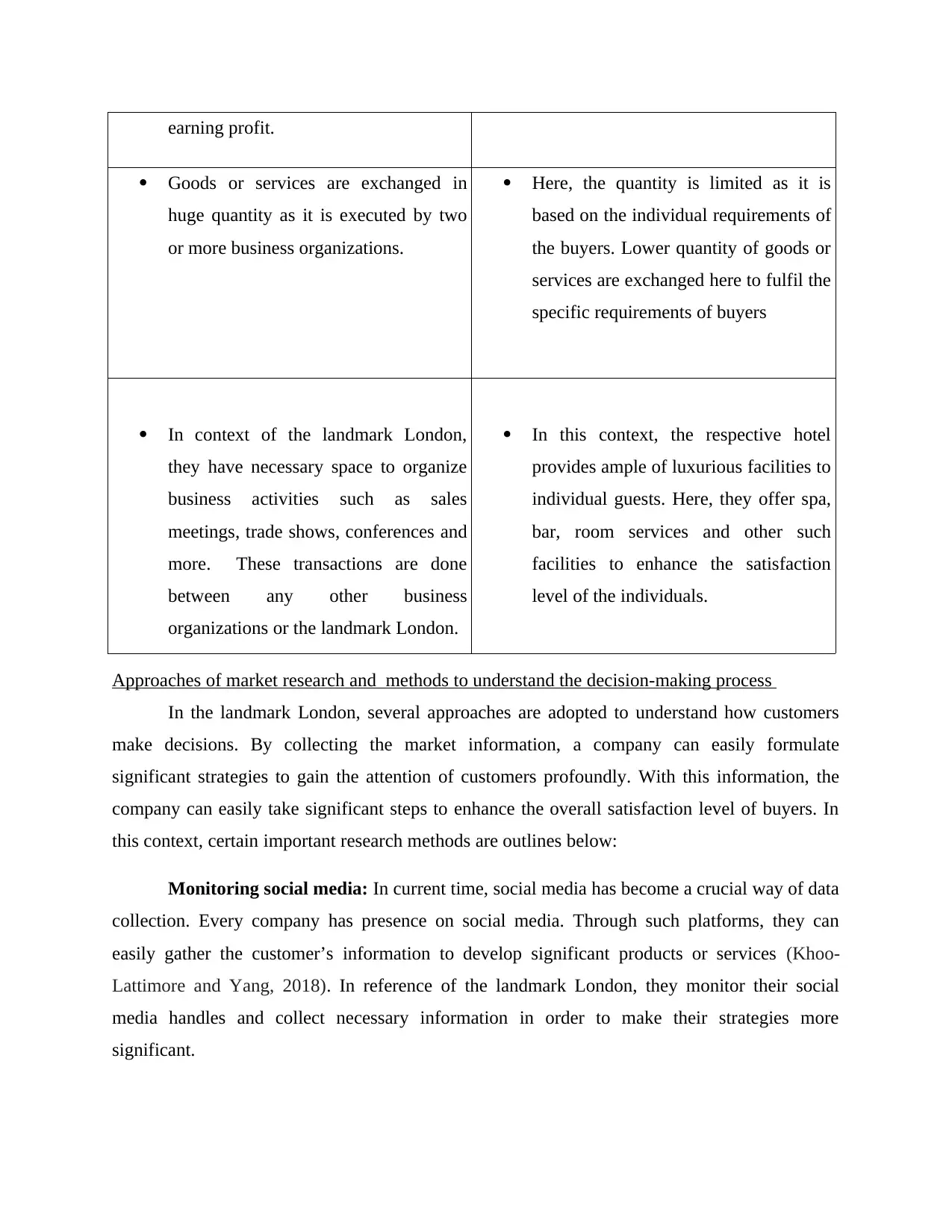
earning profit.
Goods or services are exchanged in
huge quantity as it is executed by two
or more business organizations.
Here, the quantity is limited as it is
based on the individual requirements of
the buyers. Lower quantity of goods or
services are exchanged here to fulfil the
specific requirements of buyers
In context of the landmark London,
they have necessary space to organize
business activities such as sales
meetings, trade shows, conferences and
more. These transactions are done
between any other business
organizations or the landmark London.
In this context, the respective hotel
provides ample of luxurious facilities to
individual guests. Here, they offer spa,
bar, room services and other such
facilities to enhance the satisfaction
level of the individuals.
Approaches of market research and methods to understand the decision-making process
In the landmark London, several approaches are adopted to understand how customers
make decisions. By collecting the market information, a company can easily formulate
significant strategies to gain the attention of customers profoundly. With this information, the
company can easily take significant steps to enhance the overall satisfaction level of buyers. In
this context, certain important research methods are outlines below:
Monitoring social media: In current time, social media has become a crucial way of data
collection. Every company has presence on social media. Through such platforms, they can
easily gather the customer’s information to develop significant products or services (Khoo-
Lattimore and Yang, 2018). In reference of the landmark London, they monitor their social
media handles and collect necessary information in order to make their strategies more
significant.
Goods or services are exchanged in
huge quantity as it is executed by two
or more business organizations.
Here, the quantity is limited as it is
based on the individual requirements of
the buyers. Lower quantity of goods or
services are exchanged here to fulfil the
specific requirements of buyers
In context of the landmark London,
they have necessary space to organize
business activities such as sales
meetings, trade shows, conferences and
more. These transactions are done
between any other business
organizations or the landmark London.
In this context, the respective hotel
provides ample of luxurious facilities to
individual guests. Here, they offer spa,
bar, room services and other such
facilities to enhance the satisfaction
level of the individuals.
Approaches of market research and methods to understand the decision-making process
In the landmark London, several approaches are adopted to understand how customers
make decisions. By collecting the market information, a company can easily formulate
significant strategies to gain the attention of customers profoundly. With this information, the
company can easily take significant steps to enhance the overall satisfaction level of buyers. In
this context, certain important research methods are outlines below:
Monitoring social media: In current time, social media has become a crucial way of data
collection. Every company has presence on social media. Through such platforms, they can
easily gather the customer’s information to develop significant products or services (Khoo-
Lattimore and Yang, 2018). In reference of the landmark London, they monitor their social
media handles and collect necessary information in order to make their strategies more
significant.
Secure Best Marks with AI Grader
Need help grading? Try our AI Grader for instant feedback on your assignments.
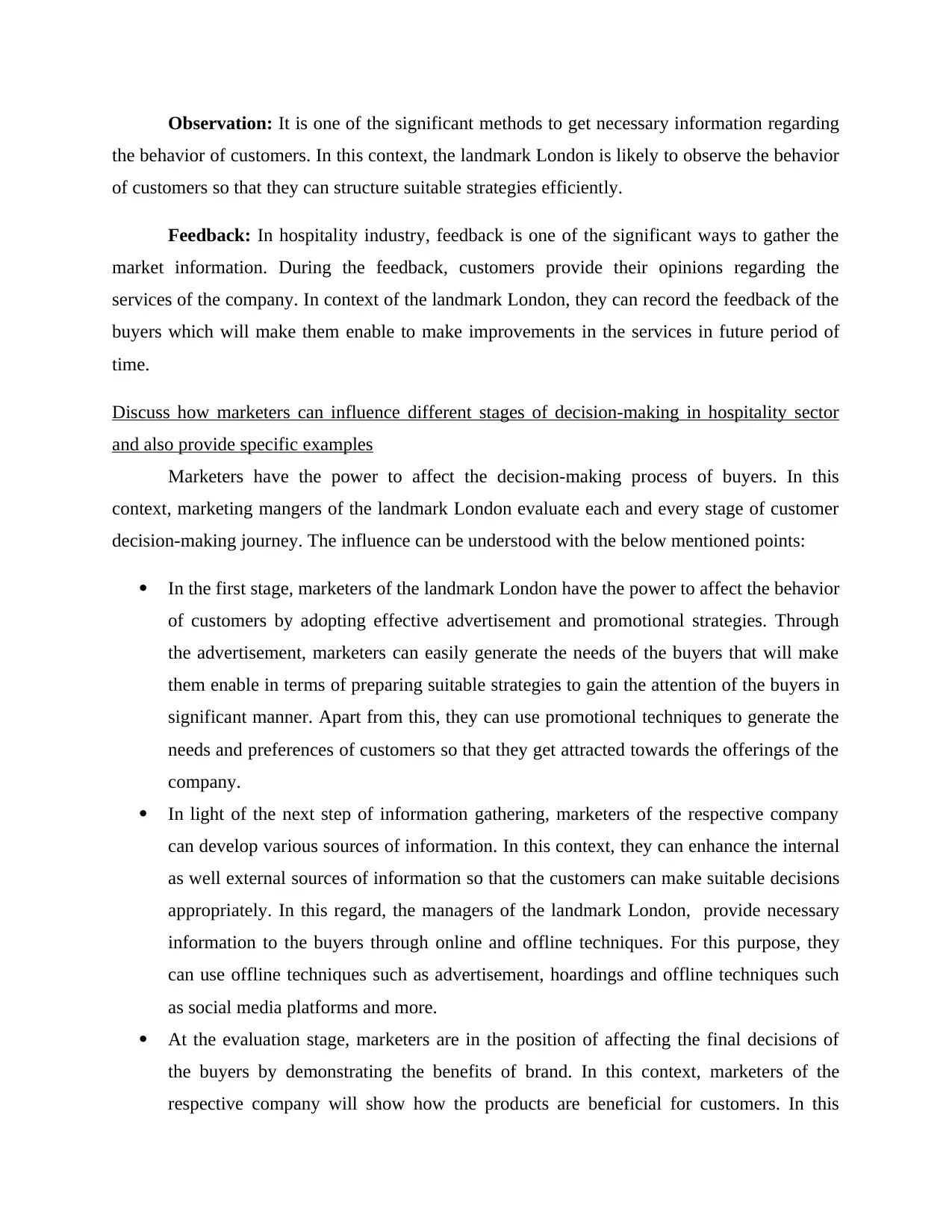
Observation: It is one of the significant methods to get necessary information regarding
the behavior of customers. In this context, the landmark London is likely to observe the behavior
of customers so that they can structure suitable strategies efficiently.
Feedback: In hospitality industry, feedback is one of the significant ways to gather the
market information. During the feedback, customers provide their opinions regarding the
services of the company. In context of the landmark London, they can record the feedback of the
buyers which will make them enable to make improvements in the services in future period of
time.
Discuss how marketers can influence different stages of decision-making in hospitality sector
and also provide specific examples
Marketers have the power to affect the decision-making process of buyers. In this
context, marketing mangers of the landmark London evaluate each and every stage of customer
decision-making journey. The influence can be understood with the below mentioned points:
In the first stage, marketers of the landmark London have the power to affect the behavior
of customers by adopting effective advertisement and promotional strategies. Through
the advertisement, marketers can easily generate the needs of the buyers that will make
them enable in terms of preparing suitable strategies to gain the attention of the buyers in
significant manner. Apart from this, they can use promotional techniques to generate the
needs and preferences of customers so that they get attracted towards the offerings of the
company.
In light of the next step of information gathering, marketers of the respective company
can develop various sources of information. In this context, they can enhance the internal
as well external sources of information so that the customers can make suitable decisions
appropriately. In this regard, the managers of the landmark London, provide necessary
information to the buyers through online and offline techniques. For this purpose, they
can use offline techniques such as advertisement, hoardings and offline techniques such
as social media platforms and more.
At the evaluation stage, marketers are in the position of affecting the final decisions of
the buyers by demonstrating the benefits of brand. In this context, marketers of the
respective company will show how the products are beneficial for customers. In this
the behavior of customers. In this context, the landmark London is likely to observe the behavior
of customers so that they can structure suitable strategies efficiently.
Feedback: In hospitality industry, feedback is one of the significant ways to gather the
market information. During the feedback, customers provide their opinions regarding the
services of the company. In context of the landmark London, they can record the feedback of the
buyers which will make them enable to make improvements in the services in future period of
time.
Discuss how marketers can influence different stages of decision-making in hospitality sector
and also provide specific examples
Marketers have the power to affect the decision-making process of buyers. In this
context, marketing mangers of the landmark London evaluate each and every stage of customer
decision-making journey. The influence can be understood with the below mentioned points:
In the first stage, marketers of the landmark London have the power to affect the behavior
of customers by adopting effective advertisement and promotional strategies. Through
the advertisement, marketers can easily generate the needs of the buyers that will make
them enable in terms of preparing suitable strategies to gain the attention of the buyers in
significant manner. Apart from this, they can use promotional techniques to generate the
needs and preferences of customers so that they get attracted towards the offerings of the
company.
In light of the next step of information gathering, marketers of the respective company
can develop various sources of information. In this context, they can enhance the internal
as well external sources of information so that the customers can make suitable decisions
appropriately. In this regard, the managers of the landmark London, provide necessary
information to the buyers through online and offline techniques. For this purpose, they
can use offline techniques such as advertisement, hoardings and offline techniques such
as social media platforms and more.
At the evaluation stage, marketers are in the position of affecting the final decisions of
the buyers by demonstrating the benefits of brand. In this context, marketers of the
respective company will show how the products are beneficial for customers. In this
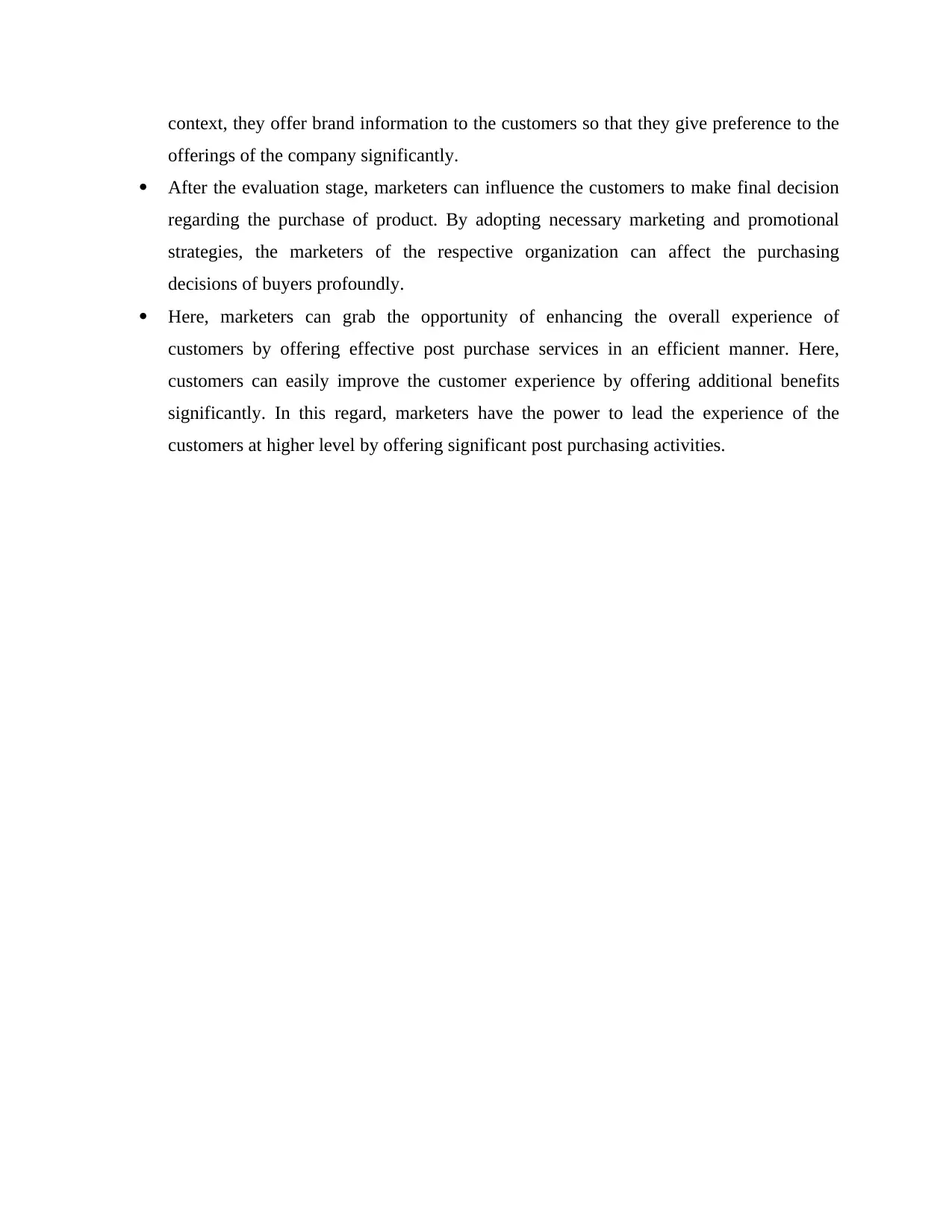
context, they offer brand information to the customers so that they give preference to the
offerings of the company significantly.
After the evaluation stage, marketers can influence the customers to make final decision
regarding the purchase of product. By adopting necessary marketing and promotional
strategies, the marketers of the respective organization can affect the purchasing
decisions of buyers profoundly.
Here, marketers can grab the opportunity of enhancing the overall experience of
customers by offering effective post purchase services in an efficient manner. Here,
customers can easily improve the customer experience by offering additional benefits
significantly. In this regard, marketers have the power to lead the experience of the
customers at higher level by offering significant post purchasing activities.
offerings of the company significantly.
After the evaluation stage, marketers can influence the customers to make final decision
regarding the purchase of product. By adopting necessary marketing and promotional
strategies, the marketers of the respective organization can affect the purchasing
decisions of buyers profoundly.
Here, marketers can grab the opportunity of enhancing the overall experience of
customers by offering effective post purchase services in an efficient manner. Here,
customers can easily improve the customer experience by offering additional benefits
significantly. In this regard, marketers have the power to lead the experience of the
customers at higher level by offering significant post purchasing activities.
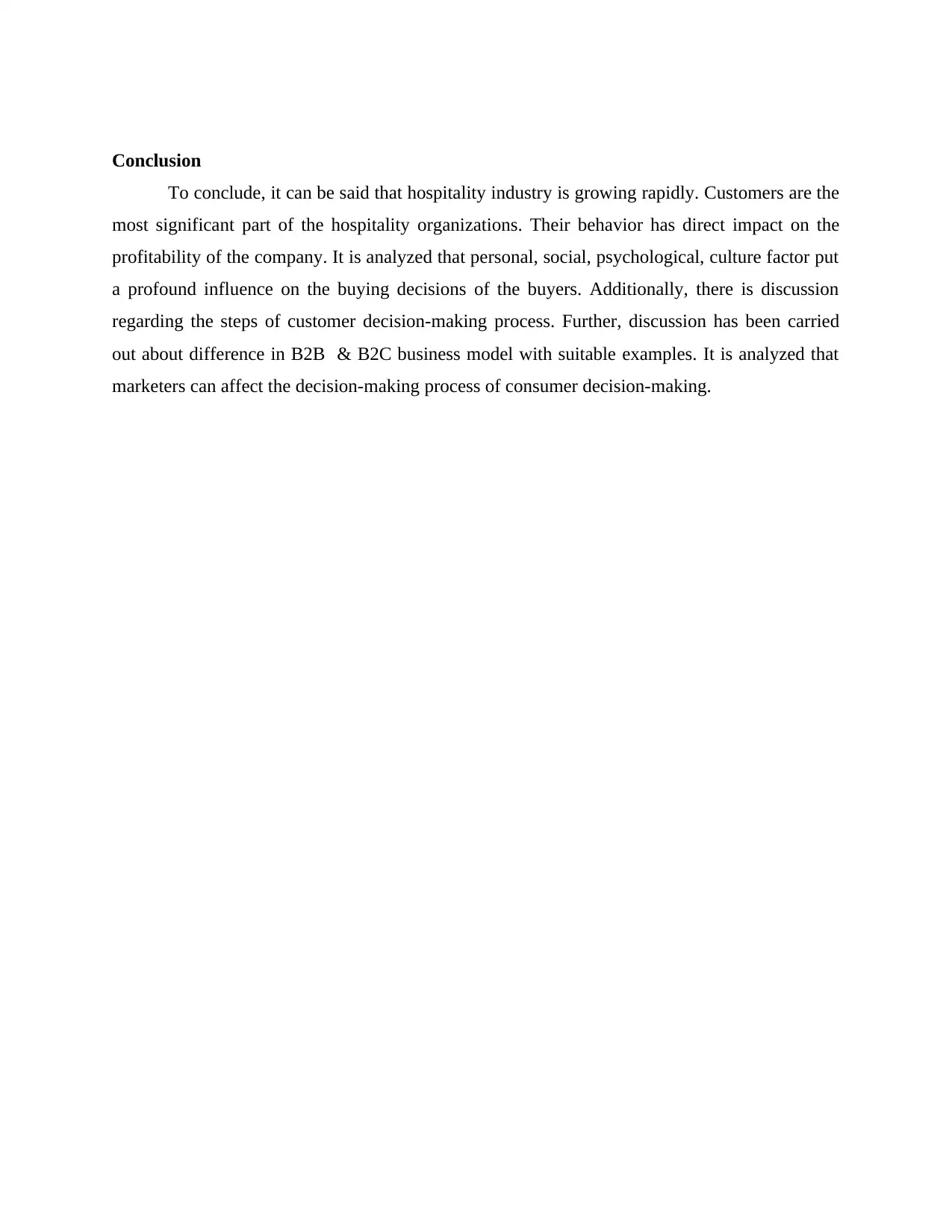
Conclusion
To conclude, it can be said that hospitality industry is growing rapidly. Customers are the
most significant part of the hospitality organizations. Their behavior has direct impact on the
profitability of the company. It is analyzed that personal, social, psychological, culture factor put
a profound influence on the buying decisions of the buyers. Additionally, there is discussion
regarding the steps of customer decision-making process. Further, discussion has been carried
out about difference in B2B & B2C business model with suitable examples. It is analyzed that
marketers can affect the decision-making process of consumer decision-making.
To conclude, it can be said that hospitality industry is growing rapidly. Customers are the
most significant part of the hospitality organizations. Their behavior has direct impact on the
profitability of the company. It is analyzed that personal, social, psychological, culture factor put
a profound influence on the buying decisions of the buyers. Additionally, there is discussion
regarding the steps of customer decision-making process. Further, discussion has been carried
out about difference in B2B & B2C business model with suitable examples. It is analyzed that
marketers can affect the decision-making process of consumer decision-making.
Paraphrase This Document
Need a fresh take? Get an instant paraphrase of this document with our AI Paraphraser
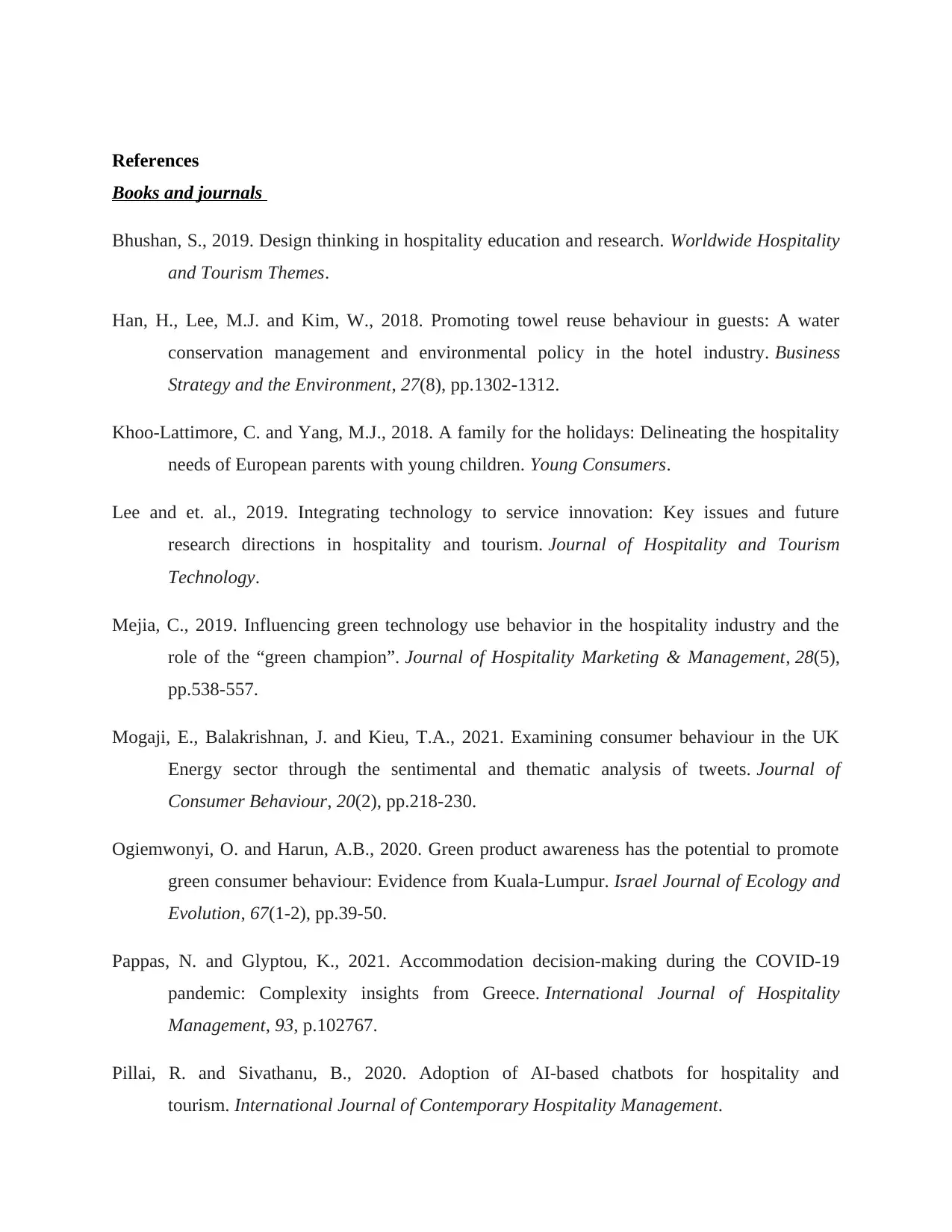
References
Books and journals
Bhushan, S., 2019. Design thinking in hospitality education and research. Worldwide Hospitality
and Tourism Themes.
Han, H., Lee, M.J. and Kim, W., 2018. Promoting towel reuse behaviour in guests: A water
conservation management and environmental policy in the hotel industry. Business
Strategy and the Environment, 27(8), pp.1302-1312.
Khoo-Lattimore, C. and Yang, M.J., 2018. A family for the holidays: Delineating the hospitality
needs of European parents with young children. Young Consumers.
Lee and et. al., 2019. Integrating technology to service innovation: Key issues and future
research directions in hospitality and tourism. Journal of Hospitality and Tourism
Technology.
Mejia, C., 2019. Influencing green technology use behavior in the hospitality industry and the
role of the “green champion”. Journal of Hospitality Marketing & Management, 28(5),
pp.538-557.
Mogaji, E., Balakrishnan, J. and Kieu, T.A., 2021. Examining consumer behaviour in the UK
Energy sector through the sentimental and thematic analysis of tweets. Journal of
Consumer Behaviour, 20(2), pp.218-230.
Ogiemwonyi, O. and Harun, A.B., 2020. Green product awareness has the potential to promote
green consumer behaviour: Evidence from Kuala-Lumpur. Israel Journal of Ecology and
Evolution, 67(1-2), pp.39-50.
Pappas, N. and Glyptou, K., 2021. Accommodation decision-making during the COVID-19
pandemic: Complexity insights from Greece. International Journal of Hospitality
Management, 93, p.102767.
Pillai, R. and Sivathanu, B., 2020. Adoption of AI-based chatbots for hospitality and
tourism. International Journal of Contemporary Hospitality Management.
Books and journals
Bhushan, S., 2019. Design thinking in hospitality education and research. Worldwide Hospitality
and Tourism Themes.
Han, H., Lee, M.J. and Kim, W., 2018. Promoting towel reuse behaviour in guests: A water
conservation management and environmental policy in the hotel industry. Business
Strategy and the Environment, 27(8), pp.1302-1312.
Khoo-Lattimore, C. and Yang, M.J., 2018. A family for the holidays: Delineating the hospitality
needs of European parents with young children. Young Consumers.
Lee and et. al., 2019. Integrating technology to service innovation: Key issues and future
research directions in hospitality and tourism. Journal of Hospitality and Tourism
Technology.
Mejia, C., 2019. Influencing green technology use behavior in the hospitality industry and the
role of the “green champion”. Journal of Hospitality Marketing & Management, 28(5),
pp.538-557.
Mogaji, E., Balakrishnan, J. and Kieu, T.A., 2021. Examining consumer behaviour in the UK
Energy sector through the sentimental and thematic analysis of tweets. Journal of
Consumer Behaviour, 20(2), pp.218-230.
Ogiemwonyi, O. and Harun, A.B., 2020. Green product awareness has the potential to promote
green consumer behaviour: Evidence from Kuala-Lumpur. Israel Journal of Ecology and
Evolution, 67(1-2), pp.39-50.
Pappas, N. and Glyptou, K., 2021. Accommodation decision-making during the COVID-19
pandemic: Complexity insights from Greece. International Journal of Hospitality
Management, 93, p.102767.
Pillai, R. and Sivathanu, B., 2020. Adoption of AI-based chatbots for hospitality and
tourism. International Journal of Contemporary Hospitality Management.
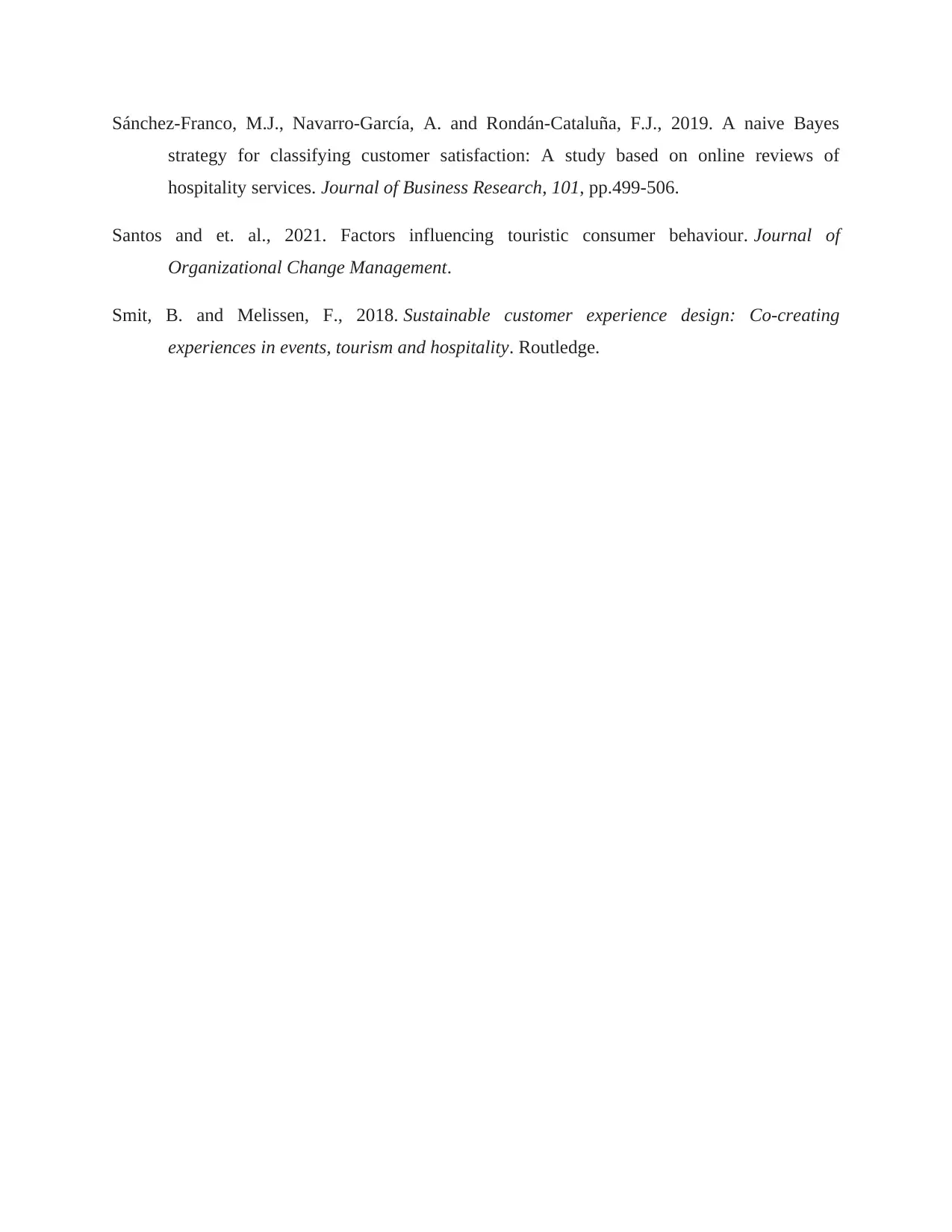
Sánchez-Franco, M.J., Navarro-García, A. and Rondán-Cataluña, F.J., 2019. A naive Bayes
strategy for classifying customer satisfaction: A study based on online reviews of
hospitality services. Journal of Business Research, 101, pp.499-506.
Santos and et. al., 2021. Factors influencing touristic consumer behaviour. Journal of
Organizational Change Management.
Smit, B. and Melissen, F., 2018. Sustainable customer experience design: Co-creating
experiences in events, tourism and hospitality. Routledge.
strategy for classifying customer satisfaction: A study based on online reviews of
hospitality services. Journal of Business Research, 101, pp.499-506.
Santos and et. al., 2021. Factors influencing touristic consumer behaviour. Journal of
Organizational Change Management.
Smit, B. and Melissen, F., 2018. Sustainable customer experience design: Co-creating
experiences in events, tourism and hospitality. Routledge.
1 out of 15
Related Documents
Your All-in-One AI-Powered Toolkit for Academic Success.
+13062052269
info@desklib.com
Available 24*7 on WhatsApp / Email
![[object Object]](/_next/static/media/star-bottom.7253800d.svg)
Unlock your academic potential
© 2024 | Zucol Services PVT LTD | All rights reserved.



